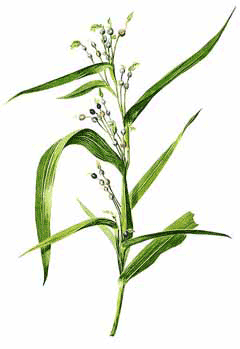
Job's Tears
Latin Name: Coix lacryma-jobi
USDA Hardiness: 8-11
Native Range: TEMPERATE ASIA: China TROPICAL ASIA: Bhutan, India, Sri Lanka, Nepal, Pakistan, Papua New Guinea, Laos, Myanmar, Thailand, Vietnam, Indonesia, Malaysia, Philippines
Edibility Rating: 3 / 5
Medicinal Rating: 3 / 5
Region:
Family:
Plant Type:
Medicinal Uses
Edible Uses
Edible Parts: Seed | Edible Uses: Coffee TeaSeed - cooked. A pleasant mild flavour, it can be used in soups and broths[269].. It can be ground into a flour and used to make bread or used in any of the ways that rice is used[1, 2, 57, 100, 183]. The pounded flour is sometimes mixed with water like barley for barley water[269]. The pounded kernel is also made into a sweet dish by frying and coating with sugar[269]. It is also husked and eaten out of hand like a peanut[269]. The seed contains about 52% starch, 18% protein, 7% fat[114, 174]. It is higher in protein and fat than rice but low in minerals[114]. This is a potentially very useful grain, it has a higher protein to carbohydrate ratio than any other cereal[57], though the hard seedcoat makes extraction of the flour rather difficult. A tea can be made from the parched seeds[46, 61, 105, 183], whilst beers and wines are made from the fermented grain[269]. A coffee is made from the roasted seed[183]. (This report refers to the ssp. ma-yuen)
Cultivation
Fodder: Bank Hypothetical Crop Management: Standard Staple Crop: Balanced carbSucceeds in ordinary garden soil[162]. Best grown in an open sunny border[1, 162]. Prefers a little shelter from the wind. Job's Tears is reported to tolerate an annual precipitation in the range of 61 to 429cm, an average annual temperature of 9.6 to 27.8°C and a pH in the range of 4.5 to 8.4[269]. Weed to some, necklace to others, staff-of-life to others, job's tear is a very useful and productive grass increasingly viewed as a potential energy source[269]. Before corn (Zea mays) became popular in Southern Asia, Job's tears was rather widely cultivated as a cereal in India[158, 269]. It is a potentially very useful grain having a higher protein to carbohydrate ratio than any other cereal[57]. The seed has a very tough shell however making it rather difficult to extract the grain. The ssp. ma-yuen. (Roman.)Stapf. is grown for its edible seed and medicinal virtues in China, the seedcoat is said to be soft and easily removed[57, 183]. This form is widely used in macrobiotic diets and cuisine[183]. The ssp. stenocarpa is used for beads[57]. Whilst usually grown as an annual, the plant is perennial in essentially frost-free areas[269]. Plants have survived temperatures down to about -35°c[160]. (This report needs verifying, it seems rather dubious[K].) Plants have often overwintered when growing in a polyhouse with us, they have then gone on to produce another crop of seed in their second year[K]. We have not as yet (1995) tried growing them on for a third year in a polyhouse[K].
Known Hazards
None known
Habitats
Wet places in grassland in the foothills of the Himalayas[146, 158]. Open sunny places to elevations of 2000 metrs in Nepal[272].
